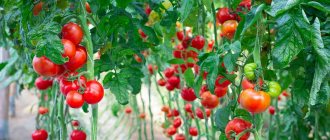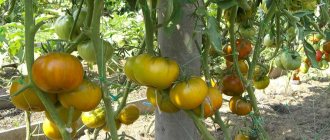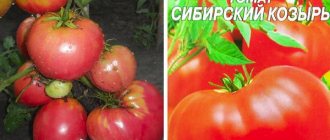The Siberian early ripening tomato was released in the late 50s of the last century thanks to the efforts of Soviet breeders. Since then, it has not lost popularity among summer residents and farmers living in areas with an unfavorable climate. This cold-resistant crop quickly takes root in the soil after planting and produces consistently high yields regardless of growing conditions.
In the article we will reveal the secret of the popularity of the variety, talk about its advantages and disadvantages, and the nuances of agricultural technology.
Characteristics and description of the variety
The early ripening variety Siberian early ripening was bred specifically for cultivation in open ground and under film covers in regions with short and cool summers. Registered in the State Register of Selective Achievements in 1959.
Originators: Federal Scientific Center for Vegetable Growing and Agrofirm Aelita LLC.
Regions of admission : North-Western, West Siberian, Northern, Volga-Vyatka, Ural, Middle Volga, Central, East Siberian, Far Eastern.
The bushes are determinate , with 3-4 compact inflorescences on the main stem. Each of them contains 3-5 fruits.
In the photo - the Siberian early ripening variety.
The distinctive features of the variety are presented in the table.
| Indicators | Characteristic |
| Fruit weight | 62-114 g |
| Form | Round and flat-round, slightly ribbed |
| Coloring | Unripe tomatoes are green with a dark green spot near the stalk, ripe tomatoes are red |
| foliage | Weak, medium-sized leaves, green and dark green in color |
| Inflorescence | Simple, less often – intermediate. The first inflorescence is formed above 6-8 leaves, subsequent ones - after 1-2 leaves |
| Pulp | Dense, juicy, with a small number of seeds. Contains 4-6% dry matter, 2.5-3.5% sugar |
| Taste | Pleasant, sweet and sour |
| Skin | Thin, but dense, does not crack |
| Number of slots | 4 or more |
| peduncle | With articulation |
| Bush height | In open ground - 40-50 cm, in closed ground - 60-90 cm |
| Purpose | Tomatoes are recommended for fresh consumption and for canning. |
| Ripening period | 98-108 days after germination |
| Productivity | 6-10 kg/m² in greenhouses, up to 7 kg/m² in vegetable gardens and greenhouses |
| Sustainability | Tobacco mosaic virus, cladosporiosis, slightly susceptible to late blight |
| Transportability | Excellent |
Advantages and disadvantages
Such a long period of cultivation of this variety already indicates that it has a huge number of positive qualities, thanks to which it is a good competitor to young modern hybrids. Among the advantages of the variety are the following:
- Good yield.
- Easy to care for.
- Simultaneous fruiting.
- Resistant to cold temperatures and adverse weather conditions.
- Suitable for cultivation in cold climates.
- Versatility of use.
- High immunity to most nightshade diseases.
Despite all the positive qualities of this variety, it still has some minor disadvantages. According to reviews of many gardeners, they are not satisfied with the following properties:
- Different sizes of tomatoes, especially in unfavorable weather conditions.
- Moral obsolescence of the variety compared to new hybrids. This is especially true for the rules of agricultural technology, productivity and fruiting.
- Weak indicators of some properties of the variety compared to new hybrids.
How to grow seedlings
The mid-season Siberian tomato is grown using the seedling method . Sowing is carried out at the end of March or at the beginning of April, 60-65 days before transferring to the ground.
Seed preparation
Connoisseurs of the variety describe frequent cases of misgrading or substitution of seeds, so they try to collect material themselves from previously grown tomatoes. You can purchase high-quality seeds from the well-known ones, “Aelita”, “Fazenda”.
Before sowing, the following manipulations are carried out with the seeds::
- Calibrated to identify empty grains. To do this, the seeds are soaked for 10 minutes in a saline solution (1 tsp per 200 ml). Those that float to the surface are thrown away, those remaining at the bottom are washed with warm running water.
- If the seed was stored in the refrigerator, perform the warming procedure one and a half months before sowing. The seeds are placed in a linen bag and placed on a heating radiator for 6-7 days.
- Seeds are disinfected in a 1% solution of potassium permanganate (30 minutes) or in a 2% solution of hydrogen peroxide (15 minutes).
- Soak in growth stimulants - "Radipharm", "Epin", "Immunocytophyte", "Heteroauxin", "Biostim" - and dry.
- They are pre-sprouted in gauze folded in several layers. The procedure promotes early emergence and increases the percentage of germination. The fabric should be damp, but excess water is unacceptable.
- They are hardened to increase the protective forces of the future plant. The sprouted seeds are placed on the bottom shelf of the refrigerator overnight and taken out in the morning. The procedure is carried out for 3-4 days in a row.
Container and soil
For growing seedlings , ordinary plastic containers, trays, boxes and cassettes, tetrapacks 5-7 cm high are suitable.
Soil for seedlings is bought in a specialized store or prepared independently from turf, river sand and humus mixed in equal proportions. The soil is disinfected by heating it in an oven, double boiler, microwave oven, or using a strong solution of potassium permanganate, Fitosporin.
About other varieties of tomatoes:
High-yielding, tasty and easy-to-care Stresa tomatoes
What kind of harvest can you expect from Early Girl tomatoes?
Sowing
Containers for growing seedlings are filled with moist soil and the seeds are planted in furrows 1 cm deep. A layer of peat is sprinkled on top and polyethylene is stretched for a greenhouse effect. The container is placed in a warm place, inaccessible to direct sunlight. Seeds without preliminary germination at an air temperature of 25°C hatch after 4-5 days. The germination period of sprouted grains is reduced by half.
Seedling care
After the first shoots appear , the film is removed and the containers are placed on the windowsill on the south side of the house.
The optimal daylight hours are 16 hours. When there is a lack of lighting, seedlings are illuminated with fluorescent lamps. At the stage of 2-3 true leaves, the seedlings are planted into separate 300 ml containers.
Watering the seedlings is moderate , after the top layer of soil has dried. A week before transferring to a permanent place, watering is stopped, the seedlings are taken out into fresh air to harden for 30-60 minutes.
For feeding, ready-made mineral complexes are used: “Agricola”, “Effecton”, “Universal”. The frequency of fertilizing is 2 times before transplanting into the ground.
Features of cultivation and care
Packages of seeds
It is known that tomatoes are heat-loving plants, however, the “Siberian early ripening” variety is resistant to the harsh climatic conditions of Russia. This feature was also reflected in the agricultural technology of this type of tomato.
Let's look at it in more detail:
Even before planting, the seeds are “hardened” by placing them (in packets!) in the refrigerator, as far as possible from the freezer. The procedure should take at least 2 months at a temperature of +2+4 degrees.
However, if this stage was missed, stratification of already swollen seeds is allowed in the refrigerator (at least 20 hours), then in a warm room at a temperature of +18 to +20 degrees.
The material for germination is placed in a nutrient solution of wood ash, then disinfected with manganese and sown in prepared soil. Additional germination of seeds before planting is allowed.
Containers with soil are covered with glass or film and left in a warm room until the first shoots, usually for 7 days. After this, the covering material is removed, the seedlings are transferred to a well-lit place on the balcony, observing the temperature regime: a gradual increase from 16 to 22 degrees. After the formation of a couple of leaves of the plant, you need to pick it.
Planting scheme
This variety can be grown using the seedless method.
Approximately 14 days before planting the seedlings in open ground, you need to start hardening them off. Containers are placed in the shade outside. At night, the tomatoes are kept in a warm room. Subsequently, the seedlings are left in partial shade, gradually accustoming them to open sunlight.
Important! You cannot immediately expose the seedlings to the sun, especially at lunchtime! The appearance of white spots on the leaves indicates sunburn; such a plant must be immediately returned to the shade!
3-4 days before planting tomatoes, seedlings should be left outside, provided that the temperature there is not lower than 12 degrees.
When to sow Siberian early ripening tomatoes?
Planting in the ground is carried out strictly 55-60 days after the sprouts appear, when 7-9 leaves appear on the trunk. After abundant watering, tomatoes should not be touched for 7-10 days. When the plants adapt, they can be fed, weeded, and hilled. You can mulch with withered grass, peat, etc., the layer should be at least 5 cm.
Is it necessary to plant Siberian early ripening tomatoes?
Tomatoes “Siberian early ripening” must be pruned every 4 days, leaving stumps of 1 cm, and also the bushes must be tied up, the leaves must be pruned, but only up to the first cluster. 30 days before harvesting tomatoes, pinch off the tops of the tops so that the fruits are larger and fleshier.
Agrotechnical techniques
The rules for cultivating tomatoes in open and closed ground are standard . They assume moderate watering, loosening, weeding, mulching the soil, forming tufts into 3 stems followed by staking, fertilizing with organic matter and minerals.
Landing
Transferring seedlings to the ground begins at the end of May or early June . In the fall, the soil is dug up and a bucket of humus is added per 1 m². In the spring, the soil is loosened, fertilized with chicken droppings (10 liters per 1 m²) and disinfected with copper sulfate (50 g of substance per 1 m²).
In the area, dig holes 20 cm deep, pour 1 tbsp into each. l. superphosphate and a handful of ash. Pour boiling water at an angle of 90°.
The seedlings are watered abundantly with warm, settled water and planted in prepared holes. Planting pattern – 30x50 cm, 3 bushes per 1 m².
Reference. Tomatoes prefer light and nutritious soil with a neutral pH=7.
Care
Rules for caring for the Siberian early ripening tomato:
- moderate watering in the morning or evening, at the root, once every 6 days;
- loosening the soil immediately after watering;
- weeding;
- forming bushes into 3 stems and tying them to supports;
- mulching the soil with pine needles, peat, straw, sawdust 2 weeks after planting.
Feeding scheme:
- The first portion of fertilizer is applied 14 days after planting: 20 g of chicken manure is dissolved in 10 liters of water. Water the bushes at the roots.
- For subsequent feedings, mineral complexes are used every 14 days: “Kemira”, “Universal”, “Rastvorin”, “BioMaster”, nitroammofoska, diammofoska - strictly according to the instructions on the package.
During the entire growth period, tomatoes are fertilized 3-4 times .
Features of growing in open and closed ground
There are no particular difficulties in cultivating the variety. The main task of the farmer is to follow the rules of agricultural technology.
Reviews from gardeners
Assessments of the quality of Siberian tomato are most often positive, but many speak neutrally about it. But there are practically no completely negative opinions.
Among the good properties of this variety are cold resistance, good yield, and the ability to enjoy tomatoes at an early age. Judging by the reviews of practicing vegetable growers, it feels great even in rainy, cool summer weather.
Positive emotions are caused by the rapid establishment of seedlings, as well as by meatier, denser fruits with a sweet taste. Some people pay attention to the minimal maintenance costs during cultivation. In particular, the variety does not require pinching or the use of pesticides, which is mandatory for most types of tomatoes.
For many, one of the arguments in favor of the “Siberian” is its suitability for preparing preparations for the winter. The possibility of growing in many climatic zones and tolerance of low temperatures are also noted. Many indicate that this variety of tomatoes is especially suitable for those who do not have greenhouses.
There is a certain pattern that it is called a reliable and proven variety, mainly by gardeners from Siberia, the Urals and the Moscow region.
Adherents of new varieties most often consider it a selection of the last century, not only in terms of the time of breeding. They consider it uncompetitive compared to the constantly updated range of hybrids. This is where the opportunity to use varieties that can resist all diseases comes into play (although such species, it seems, do not exist in nature). Pay attention to the poor quality of the seeds sold.
Each vegetable grower has his own requirements for plants. And also, as you know, “the point of view depends on where you sit,” that is, where you live. Here, a lot depends on the suitability of the variety to certain climatic conditions, the properties of the existing soil, and simply the inclination to experiment or follow the beaten path.
Harvesting and application
When grown in a greenhouse, the first harvest is harvested at the end of June, in the garden - 2 weeks later.
Tomatoes have a pleasant sweet and sour taste . Some farmers describe it as a classic tomato. The high content of dry substances (up to 6%) allows you to prepare tasty and rich tomato juice, pasta, and various sauces. Tomatoes are good fresh or pickled.
The fruits tolerate transportation well if they are placed in wooden boxes in one layer.
Description of fruits
Unfortunately, or fortunately for vegetable growers, breeders around the world are working hard not only on disease resistance, but also on the taste of fruits. A person no longer wants to eat just a tomato, he wants unsurpassed taste, amazing aroma and a long aftertaste.
The Siberian early ripening tomato cannot boast of any of the listed qualities. In the register of varieties, its taste is listed as satisfactory. This tomato has a pronounced sourness, and if the summer was not at all pleasant with sunshine, then the fruits are only suitable for processing.
May be interesting Pepper “Bull”: a sought-after variety with high quality fruitsWinter tomato gardenApricot “Red-cheeked” - a time-tested variety
This tomato belongs to the salad varieties. At that time, the middle of the last century, its taste was quite acceptable. However, in these days of culinary delights, vegetable growers no longer want to grow just tomatoes, but are increasingly giving preference to tasty salad varieties, to which this variety does not belong.
Reviews
Gardeners' opinions about the Siberian early ripening variety are divided . Some call it an ideal option for regions with cold climates, others believe that it is high time to forget about it, because many new interesting tomatoes have appeared on the market over the past decades.
Olga, Satka : “I remember how my mother grew this variety 15 years ago, and she still does it. I don’t like fresh tomatoes, they’re too sour, but for pickling and pickling you won’t find a better one. Caring for them is simple. It is necessary to moderately moisten the soil and feed it with organic matter and minerals.”
Evgenia, Novokuznetsk : “These tomatoes are the best that can be grown in our cold region in the garden. I have been planting Siberian early ripening for 10 years and am always pleased with the result. I collect the seeds myself, dry them and store them in a cool place. Germination is 100%, seedlings take root in any conditions, and the yield is surprisingly high.”
Care
After the plants are planted in the ground, it will be necessary to form them correctly - no more than 3 stems should remain on each bush. It is also important to prevent leaves and fruits from touching the ground.
It is also important to note that flowers should not be allowed to fall off, since the yield depends on them. Therefore, when the lower flowers begin to fall off, you will need to plant a bush above the next cluster.
You need to water the bushes only after the sun has set and only with warm water. The soil must be constantly loosened and weeds must not appear, otherwise the bushes will not have enough air.
Despite the fact that the Siberian early ripening variety is considered strong and resistant to pests and diseases, it is worth taking care of preventive treatment:
- Aphids, whiteflies, and mole crickets will not touch bushes treated with insecticides.
- Gray rot, fusarium and other diseases will not appear if fungicidal agents are used.
It is important to follow the instructions when using these products so that they only harm the pests and not the plants.
Additionally, planting celandine, calendula and marigolds near tomatoes can help. These are all important points that you should pay attention to when working with the Siberian early ripening variety. And even though the variety is not the best in many respects for a long time, because there are more fruitful and strong hybrid varieties, Siberian early ripening is still loved by many because, despite the changing climate, it continues to delight experienced gardeners with its delicious fruits.
Sowing and growing seedlings
Suitable for growing indoors and outdoors. An unpretentious tomato will prefer fertile and loose soil, although it is not particularly picky about it.
Sowing occurs no later than the end of April, but not earlier than mid-March. The seeds are pre-treated with potassium permanganate and hardened. Tomatoes survive transplantation well, so they can be sown either in separate containers or in a box for subsequent picking (this occurs in the phase of 2 true leaves).
Caring for seedlings involves timely watering and fertilizing.
Important! Early ripening tomato seedlings are planted in a greenhouse or outside no later than 50-60 days from germination. Overgrown bushes will hurt and grow slower. Therefore, in warm climates, earlier sowing is allowed.
General information
The Siberian early ripening tomato variety belongs to the determinant group, since at a certain point growth stops and does not require pinching the top. On average, the height of a bush is 50 cm, but it can grow up to 90 cm. Tomatoes can be grown both in open beds and in a greenhouse. Ideal for growing in the short, not too warm summers of Siberia.
Features of the plant:
- the stem is strong, with a lot of foliage;
- medium-sized leaves have a dark green color;
- 6 tomatoes are formed on one brush;
- the roots do not go too deep into the ground, but have many branches;
- the fruits begin to ripen early, approximately 110 days after planting the seeds;
- resists many diseases well.
Tomatoes of the Siberian early ripening variety are remembered for the following characteristics:
- the weight of one fruit is about 70 g;
- the surface has a bright red color;
- round shape with slight ribbing;
- small content inside the seeds;
- dense fleshy pulp contains enough juice;
- The thick skin prevents cracking, the vegetable is well stored and easily transported.
The yield is high, the berries begin to ripen at the same time, which is convenient when preparing dishes for the winter. When grown in greenhouse conditions, up to 1 kg of fruit can be collected from one bush. A tomato grown in open ground will give a slightly smaller yield, about 600 grams.
History of selection
The variety was developed as a result of crossing two hybrids. The resulting offspring underwent individual selection, after which the seeds were put on sale. Despite the venerable age of the cultivar, summer residents still grow it, which indicates its reliability and demand. Siberian early ripening is a variety, not a hybrid, so every vegetable grower can collect seeds from it independently.










